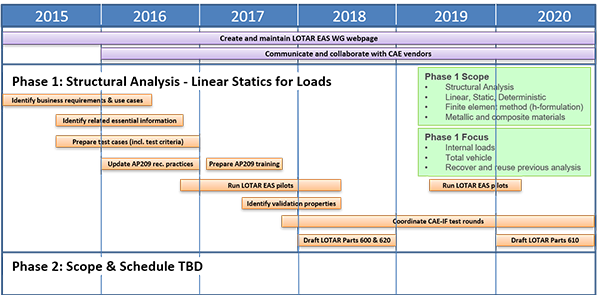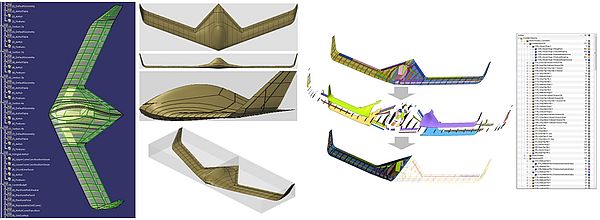LOTAR EAS: Planning & Accomplishments
Planning
Figure 3 illustrates the timeline for Phase 1 development efforts.
Figure 3: LOTAR EAS WG initial planning
Accomplishments
2019
- Successfully completed Pilot Study #3 (AP209 to Nastran translator) and Pilot Study #4 (Implementation of FEA Validation roperties)
- Supported the CAE-IF extended test rounds R3S (round trip), R4S (model level FEA Validation Properties) and R5S (loadcase level FEA Validation Properties)
- Supported the development of Recommended Practices for FEA Validation Properties
- Continued the development of the AP209 Ed.2 Linear Statics Structural FEA Handbook (Available on the CAE-IF website):
- Published Volume 2: Subcases, Loads, Boundary Conditions
- Drafting Volume 3: Output requests, Results
- Developing a NAFEMS brochure on “What is STEP for managing CAD/CAE data?” in collaboration with NAFEMS SDMWG
- Drafted LOTAR Parts 600 and 620
- Successfully presented a live demonstration of a round trip from/to native FEA format using STEP AP209 Ed.2 for the NAFEMS World Congress June 2019 – Quebec, Canada with the support of the CAE-IF participants and prepared a video of the demo
2018
- Completed Pilot Study #2 (FEA outputs)
- Supported the CAE-IF test rounds R2S (FEA results) and R3S (round trip)
- Developed the definition of FEA validation properties
- Published the AP209 Ed.2 Linear Statics Structural FEA Handbook Volume 1 (coordinate systems, nodes, elements, properties and materials) on the public area of CAx-IF website
- Developed the AP209 Handbook Volume 2 (subcases, loads, boundary conditions) and Volume 3 (output requests, results)
- Drafted content for NAS/EN-9300-620 “Part 620: LOTAR of FEA Structural Analysis information”
- Submitted LOTAR EAS newsletters published in NAFEMS Benchmark magazine (April 2018, July 2018)
- Presented at various NAFEMS events
- Signed an extended MoU with NAFEMS and LOTAR supporting associations
2017
- Launched Pilot Study #2 (FEA outputs)
- Successfully completed Pilot Study #1 (FEA inputs)
- Developed the AP209 Ed.2 Linear Statics Structural FEA Handbook Volume 1 (coordinate systems, nodes, elements, properties and materials) based on the test models used in the pilot
- Defined validation properties for AP209 Ed.2 file exchange
- Updated the STEP File Analyzer to support AP209 Ed.2 and implemented a visualizer of the FEA mesh, loads and boundary conditions (NIST)
- Presented LOTAR EAS status at NAFEMS events
- Launched the CAE-IF and completed the first interoperability test round (R1S) based on AP209 Ed.2
- LOTAR EAS first newsletter was published in NAFEMS Benchmark magazine (Oct. 2017)
- Updated the STEP File Analyzer to support AP209 Ed.2 and implemented a visualizer of the FEA mesh, loads and boundar conditions and results (NIST)
2016
- Updated AP209 Recommended Practices document consistent with AP209 Ed.2 IS
- Signed MoU with NAFEMS to approach CAE vendors with joint communication for development of AP209 Ed.2 translators
- Developed detailed planning for execution of initial AP209 Ed.2 Pilots (Q3 2016)
- Presented LOTAR EAS activities and pilots to CAE vendors and service providers
- Presented LOTAR EAS activities at various NAFEMS local events
- Defined training materials for AP209 Ed.2 for various audiences
- Outlined the structure of Part 600 “Fundamentals and Concepts for LOTAR of EAS information”
2015
- Engaged NAFEMS Simulation Data Management Working Group for collaboration
- Submitted first LOTAR webpage for EAS WG
- Selected test model for LOTAR use cases in initial phases
- Outlined business requirements for use case
- Reviewed existing test case models developed for AP209 Ed.1
- Defined milestones through 2015
- Established plan for engaging CAE vendors in supporting EAS
- Identified other like-minded CAE forums to engage
- Integrated potential new resources from National Institute of Standards and Technology (NIST)
- Contracted Keith Hunten to update AP209 Ed.2 Recommended practices and knowledge transfer
- Developed the baseline model for LOTAR test model in Phase 1
Figure 4: LOTAR EAS Ultra-Light Glider Test Model
2014
- Engineering Analysis & Simulation Working Group initiated in April 2014 and officially created in December 2014
- Identified and prioritized engineering analysis & simulation disciplines and domains
- Developed and proposed structure for Parts 6xx family
- Created first draft of business requirements, use cases and working plan related to Phase 1


